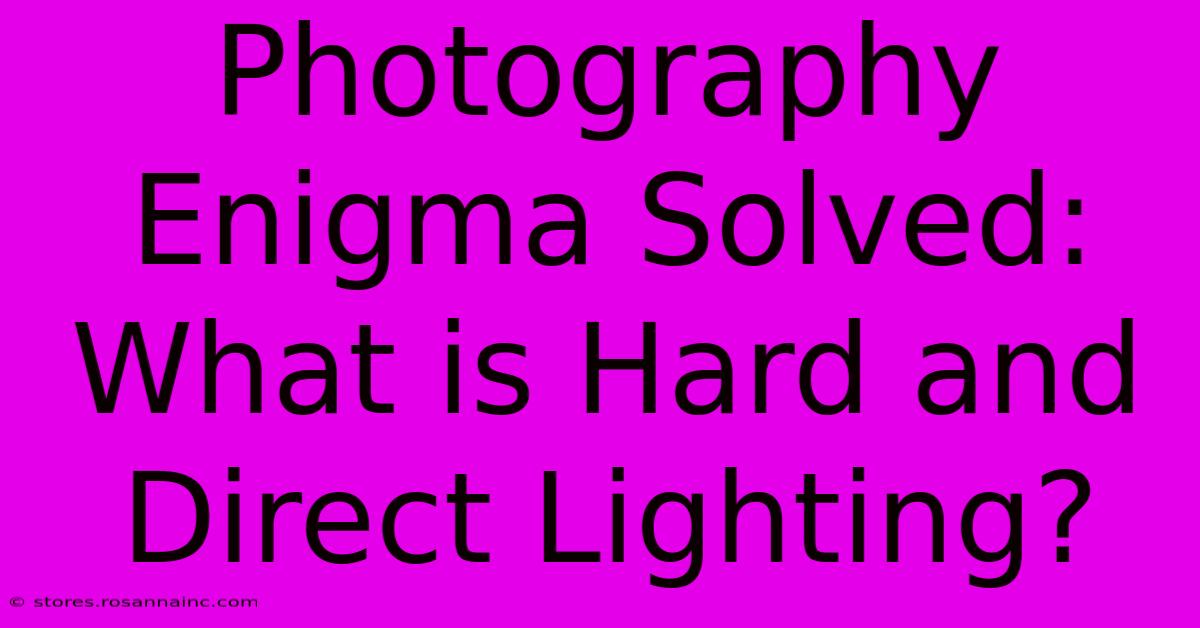Photography Enigma Solved: What Is Hard And Direct Lighting?

Table of Contents
Photography Enigma Solved: What is Hard and Direct Lighting?
Understanding lighting is crucial for any photographer, whether you're a seasoned pro or just starting out. One of the fundamental concepts to grasp is the difference between hard and direct lighting. This seemingly simple distinction significantly impacts the mood, style, and overall quality of your images. This comprehensive guide will demystify hard and direct lighting, explaining their characteristics, applications, and how to effectively utilize them in your photography.
What is Direct Lighting?
Direct lighting, at its core, means light that travels directly from its source to the subject without any significant diffusion or bouncing. Think of the sun on a clear day, a bare bulb, or a flash without a diffuser – these are all examples of direct light sources. The key characteristic is the lack of any softening or scattering of the light before it hits your subject.
The Impact of Direct Light
The effect of direct lighting is often dramatic. It creates strong contrasts between light and shadow, resulting in:
- High contrast: Bright highlights and deep, dark shadows are hallmarks of direct lighting.
- Defined textures: The strong shadows accentuate the texture of surfaces. This can be beneficial for showing detail in rough surfaces like wood or stone, but it can also be harsh on skin.
- Sharp details: Direct light casts defined shadows, emphasizing sharp details and edges.
What is Hard Lighting?
Hard lighting is a type of direct lighting. The crucial difference is the size of the light source relative to the subject. Hard lighting is characterized by a small light source, which results in intensely defined shadows with sharply defined edges. Think of the sun at midday, a small flash unit without a diffuser, or a tiny window as your light source.
Identifying Hard Lighting
You can easily identify hard lighting by examining the shadows:
- Small, Intense Shadows: The shadows are clearly defined and sharply edged, lacking any gradual transition between light and dark.
- High Contrast: The contrast between the brightly lit areas and the deep shadows is very noticeable.
- Harshness: The overall effect can appear harsh and unforgiving, especially on portraits.
Soft Lighting vs. Hard Lighting: A Crucial Comparison
To fully understand hard lighting, it's beneficial to compare it to its opposite: soft lighting. Soft lighting uses a larger light source (relative to the subject) that diffuses the light, creating softer shadows with less contrast. The sun on an overcast day, a large softbox, or a diffused flash are examples of soft light sources.
| Feature | Hard Lighting | Soft Lighting |
|---|---|---|
| Light Source | Small relative to subject | Large relative to subject |
| Shadow Quality | Small, dark, sharply defined | Large, soft, gradually fading |
| Contrast | High | Low |
| Texture | Emphasized | Softened |
| Overall Feel | Dramatic, harsh, intense | Gentle, even, flattering |
Mastering Hard and Direct Lighting in Your Photography
While soft lighting is often preferred for portraits because of its flattering nature, hard lighting is a powerful tool in a photographer's arsenal. Here are some tips on effectively using hard light:
Utilize Hard Light for:
- Dramatic Portraits: Hard lighting can create striking and moody portraits, particularly if you want to evoke a sense of drama or mystery.
- Product Photography: It's excellent for showcasing the texture and details of products.
- Architectural Photography: Hard light can highlight the architectural details and create strong shadows that enhance the structures.
- Still Life Photography: Similar to product photography, it can create interesting contrast and shadows.
Techniques for Modifying Hard Light:
You can soften hard lighting by using:
- Reflectors: Bounce light back onto the shadowed areas to fill them in.
- Diffusers: Place diffusers between the light source and the subject to soften the light.
- Time of Day: Shoot during the "golden hour" (sunrise and sunset) for softer, more diffused sunlight.
Conclusion: Embracing the Power of Hard and Direct Lighting
Hard and direct lighting, while sometimes perceived as challenging, are versatile tools offering a unique aesthetic. By understanding their properties and employing the right techniques, you can harness their power to create captivating and evocative images, expanding your photographic creativity significantly. Experiment with different light sources and modifiers to develop your own unique style. Remember, mastering light is key to mastering photography.

Thank you for visiting our website wich cover about Photography Enigma Solved: What Is Hard And Direct Lighting?. We hope the information provided has been useful to you. Feel free to contact us if you have any questions or need further assistance. See you next time and dont miss to bookmark.
Featured Posts
-
Scribes Silver The Hidden Significance Of Medieval Woodcut Monies
Feb 05, 2025
-
Dominate Your League With These Girl Power Fantasy Football Names
Feb 05, 2025
-
Witness The Rainbows Birth Explore The Magical Transformation When Green Meets Yellow
Feb 05, 2025
-
Code Blue Crack The Mystery Of Iceberg Blues 00849 B Radiance
Feb 05, 2025
-
9 Sizzling Secrets Unlocking The Job Market At The Morgan Museum
Feb 05, 2025
